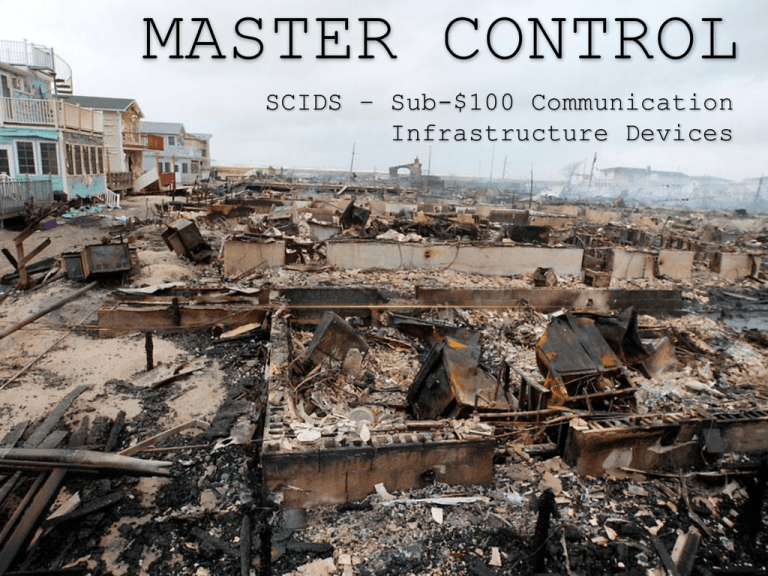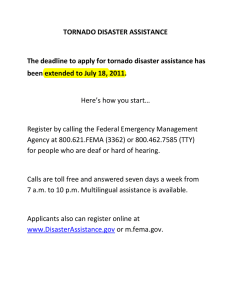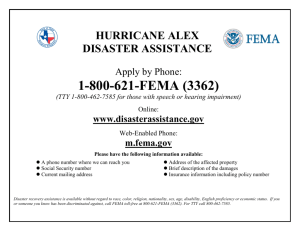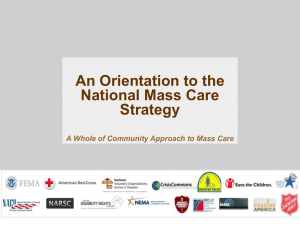MASTER CONTROL SCIDS – Sub-$100 Communication Infrastructure Devices
advertisement

MASTER CONTROL SCIDS – Sub-$100 Communication Infrastructure Devices TEAM BLACK Matthew Bartkus Dominic Brooks Joshua Cruz Evan Savaria Daniel Swift Xiao Lin Mentor: Justin Brunelle 2/27/2014 2 OUTLINE • Define Problem Historically • Problem Evaluation • Problem Statement • Customer Information • Current Process Model • Solution Statement • Solution Objectives • Solution Principles • Required Hardware and Software Components • Solution Benefits and Problems 2/27/2014 3 XIAO LIN PRESENTING… • Define Problem Historically • Problem Evaluation 2/27/2014 4 DEFINE PROBLEM HISTORICALLY • Lack of Interoperability • Incompatible and Aging Communications Equipment • Funding • Planning • Cooperation • Radio Spectrum 2/27/2014 5 PROBLEM EVALUATION • Communication Being Ridiculously Inefficient During Disaster • Hundreds Failed to Receive Warning in 9/11 • Columbine High School Massacre • Oklahoma City Bombing • Ohio River Flooding 2/27/2014 6 PROBLEM STATEMENT Communication during disaster relief efforts becomes unreliable and ineffective when terrestrial networks are damaged. Unreliable and ineffective communication disrupts the coordination of relief efforts and the collection and dissemination of information vital to responders. 2/27/2014 7 DANIEL SWIFT PRESENTING… • Identify Case Study • Case Study Specific Problem Evaluation 2/27/2014 8 SCIDS - MASTER CONTROL 2/27/2014 9 INTERFACE AND DATABASE SCIDS Master control serves as an interface and database that passes dispatch orders from the relief command center to response teams and taking in response team reports through the SCIDS data protocol. 2/27/2014 10 UPDATE NATIONAL DATABASES Its secondary function is to update national relief databases in an effort to coordinate the overall relief in the event of a disaster. 2/27/2014 11 MATT BARTKUS PRESENTING… • Customer Information • Current Process Model 2/27/2014 12 CUSTOMER INFORMATION • Individuals and agencies involved in relief efforts • Individuals affected by the disaster • Volunteers • Private relief organizations • Government agencies • Fifteen emergency support functions (ESFs) • Communication • Emergency Management 2/27/2014 13 MCOV NEMIS CURRENT PROCESS FEMA Liaison Officers Response Team Response Team Command Center/Dispatch In-Person Communication 2/27/2014 14 DIAGRAM SOURCES • An Analysis of Inter-Agency Radio Communications with Emergency Responders • Liaison Officer Position Checklist • NEMIS-MT User Manual • Why Can’t We Talk? Working Together To Bridge the Communications Gap To Save Lives 2/27/2014 15 DOMINIC BROOKS PRESENTING… • Solution Statement • Solution Objectives 2/27/2014 16 OUR SOLUTION… The SCIDS project aims to solve the issues of communication first responders have, in an inexpensive, versatile and efficient manner. 2/27/2014 17 OUR OBJECTIVES… • Transfer of data to and from SCIDS devices • Streamlined, User-Friendly User Interface • Robust and versatile alert system • Interoperability with other devices 2/27/2014 18 Joshua Cruz Presenting… • Improved Process Flow • Competition 2/27/2014 19 MCOV NEMIS Old Process FEMA Liaison Officers Response Team Response Team Command Center/Dispatch In-Person Communication 2/27/2014 20 Command Center FEMA Liaison Officer(s) / Dispatch Team Improved Process Information Flow Key External Database (NEMIS,IRIS,etc.) Dispatch/MASTER CONTROL Response Team Reports Updates from External Source SCID MASTER CONTROL Data Protocol Response Team(s) With SCIDS Hand-held 2/27/2014 21 Competition • • • There is no “competition” Master Control aims to mimic, combine, and extend the functionality of existing data storage systems Policies to keep in mind National Incident Management Systems Presidential Policy Directive 8 National Disaster Recovery Framework 2/27/2014 22 EVAN SAVARIA PRESENTING… • Required Hardware and Software Components • Solution Benefits and Problems 2/27/2014 23 REQUIRED HARDWARE COMPONENTS 2/27/2014 24 REQUIRED SOFTWARE COMPONENTS • Database Software • Software providing the GPS coordinates of the responders 2/27/2014 25 SOLUTION BENEFITS • 100% communication in times of disaster • Low cost to setup and maintain • Private Network 2/27/2014 26 PROBLEMS WITH SOLUTION • Coordinating efforts is a very difficult task • Communication interference and delay • User Error • Master Control failure renders entire system useless 2/27/2014 27 THE END 2/27/2014 28 REFERENCES • FEMA. Disaster Emergency Communications Division. FEMA, 17 Aug 2012. Web. 10 Feb 2014, <http://www.fema.gov/disaster-emergency-communicationsdivision/ >. • FEMA. Emergency Support Function Annexes: Introduction. FEMA, 2008. PDF file. • FEMA. • Gay, Ronald J. An Analysis of Inter-Agency Radio Communications with Emergency Responders. Florida Department of Law Enforcement, n.d. PDF file. • National Task Force on Interoperability. Why Can’t we Talk? Working Together To Bridge the Communications Gap To Save Lives. NTFI, 2005. PDF file. NEMIS-MT User Manual. FEMA, 2014. PDF file. 2/27/2014 29




